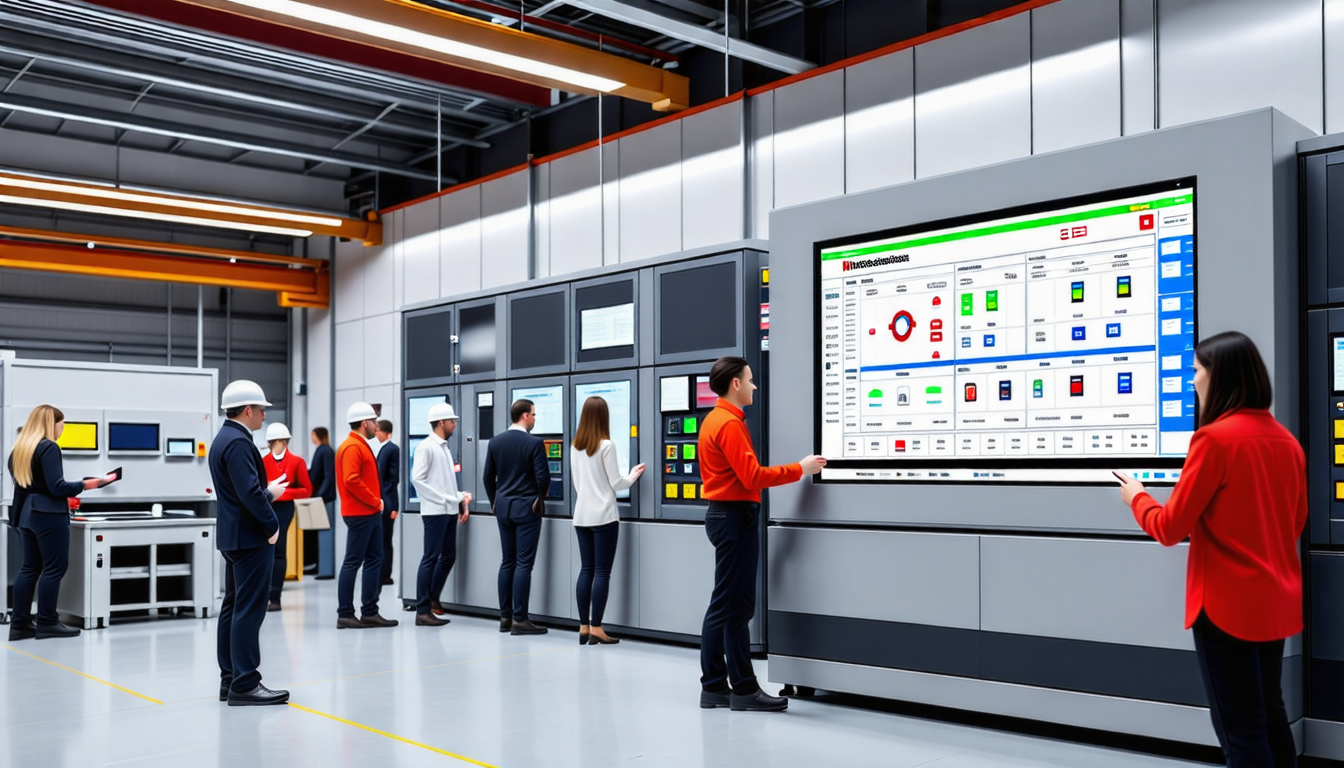|
IN BRIEF
|
Selecting the right Mitsubishi Electric HMI is a crucial step in optimizing industrial automation processes. With various options available, understanding the key aspects of performance, reliability, and redundancy is essential for making an informed decision. Additionally, factors such as technical support and protocol connectivity should be prioritized, as they impact the integration and communication capabilities of the system. Assessing the flexibility and proven track record of different models will ensure the chosen HMI meets the specific needs of your application. Moreover, utilizing tools like the FA Integrated Selection Tool can facilitate the evaluation of product combinations and configurations. This guide will outline critical elements to consider when embarking on the journey to select an effective Mitsubishi Electric HMI for your industrial tasks.

Selecting an appropriate HMI (Human-Machine Interface) requires a systematic approach involving multiple considerations, given the importance of this equipment in streamlining operations and enhancing efficiency. Mitsubishi Electric offers a range of HMIs that cater to diverse industry needs. Understanding how to evaluate these options will ensure you choose a device that meets your operational requirements.
Defining your requirements
Before diving into specific models, it’s crucial to define the operational requirements of your system. Identify factors such as the environment where the HMI will be placed, the scale of operations, and user interaction preferences. Determine the types of processes you intend to monitor or control, and how the HMI will integrate with existing systems. This groundwork will guide your selection process effectively.
Performance metrics
Performance is a substantial criterion when selecting a Mitsubishi Electric HMI. Consider the speed of the HMI in processing and displaying data, as well as response time to user inputs. High-performance HMIs reduce lag during operation, leading to increased productivity. Evaluate specifications such as CPU speed and memory capacity to ensure the HMI can handle your application demands efficiently.
Reliability and durability
Reliability is another essential factor, especially for critical operations that require continuous uptime. Mitsubishi Electric HMIs are designed for various environments, including harsh industrial settings. Investigate the durability ratings of potential models, focusing on factors such as temperature ranges, dust, and moisture resistance. Reliable devices will reduce maintenance requirements and overall operational interruptions.
Redundancy options
In mission-critical applications, redundancy can be pivotal. Mitsubishi Electric offers HMIs that can work in tandem with backup systems, ensuring seamless operation even in the event of a primary unit failure. Evaluate redundancy features when selecting an HMI to mitigate risks associated with system downtime, thereby maintaining operational integrity.
Technical support and service
Working with complex systems creates the possibility of needing technical assistance. Assess the level of technical support provided by Mitsubishi Electric before making a decision. This includes availability of warranty services, ease of accessing customer support, and the existence of comprehensive online resources, such as forums and detailed manuals. Robust support options can significantly ease the challenges encountered during setup and operation.
Protocol connectivity
Another critical aspect to address is protocol connectivity. Ensure that the Mitsubishi Electric HMI supports both northbound and southbound protocols that are relevant to your current systems. Compatibility with major communication standards, such as Ethernet/IP and Modbus, will facilitate smoother integration and data exchange between devices. This capability extends the operational scope of your HMI and enhances system flexibility.
Flexibility in design and functionality
Flexibility in terms of design and functionality is vital to adapting the HMI to the specific needs of operators. Mitsubishi HMIs offer customizable interfaces and layouts, allowing users to tailor the display to suit different applications. Look for HMI models that provide options for changing screen designs, and adding or removing functionality based on evolving operational requirements.
Proven track record
Selecting a product with a proven track record can significantly reduce the risks associated with your decision. Research past implementations and user testimonials regarding the reliability and performance of particular Mitsubishi Electric HMI models. Proven success in similar applications can provide confidence in your choice and assurance that the HMI will perform well in your setting.
Using Mitsubishi’s Selection Tools
Mitsubishi Electric provides valuable resources to assist in product selection. The FA Integrated Selection Tool allows you to perform necessary calculations for checking product combinations and selecting models efficiently, without the hassle of scouring through manuals. This tool helps visualize requirements and compare different HMI options together, simplifying your selection journey.
Programming capabilities
Understanding the programming capabilities of the HMI is crucial for leveraging full functionality. Mitsubishi Electric HMIs can be programmed using GT Works’ GT Designer 3 and GX Developer software. Familiarizing yourself with these programming tools will enhance your ability to set up and control on/off bits effectively. Evaluate how user-friendly the programming environment is, as this will significantly influence operational efficiency.
Sample configurations
To further facilitate your decision-making, utilize Mitsubishi’s sample configurations. By reviewing these configurations, you can gain insights into various applications and setups that others have successfully implemented. This knowledge can highlight applicable features and provide context around how specific functionalities can enhance your operational framework.
Integration with MELSOFT GT Works3
Mitsubishi Electric’s MELSOFT GT Works3 offers advanced screen creation features that can streamline the design process for HMIs. Users can select from a variety of preset themes, enabling rapid selection of appealing designs for screen backgrounds. Such features not only enhance user experience but also allow for a unique interface that symbolizes your company’s branding. Evaluate how the integration of design tools can ease the burden of repetitive tasks and improve usability.
Considering extension modules
Investigating options for extension modules compatible with Mitsubishi Electric PLCs can expand operational capabilities significantly. Understanding the available extension modules can help tailor your HMI for specific tasks or improvements in functionality. Details on the various extension modules can be found at this link, which provides insights into how they can enhance your HMI setup.
Enhanced productivity solutions
Lastly, consider the productivity enhancements available through solutions like the GOT Remote Solutions offered by Mitsubishi Electric for the GOT2000 series. Such systems improve the monitoring capability of HMIs, allowing for better oversight and response time in operational processes. Exploring how these enhancements fit within your operational framework could yield significant benefits. More information on these advancements can be accessed through this link.
By systematically evaluating each of these components, you’ll be well-equipped to select the most suitable Mitsubishi Electric HMI for your specific needs, ensuring that the device enhances your system’s efficiency and reliability. Each consideration will play a vital role in making an informed decision that aligns with both current and future operations.
Choosing the right Mitsubishi Electric HMI requires careful consideration of several key factors. Start by evaluating the performance and reliability of the system, ensuring it meets your operational demands. Redundancy is crucial for maintaining uptime, so assess options that provide backup solutions. Additionally, examine the level of technical support available to ensure assistance when needed. Connectivity options are also important; verify the protocols supported for both northbound and southbound communication. Lastly, flexibility in design and functionality can enhance user experience, making it easier to adapt the HMI to specific applications. With these considerations, you can make an informed selection that aligns with your industrial needs.
FAQ on Selecting a Mitsubishi Electric HMI
What factors should I consider when choosing an HMI?
When selecting an HMI, it’s important to evaluate performance, reliability, redundancy, technical support, and both northbound and southbound protocol connectivity.
How can I select the right communication method for my HMI?
There are various solutions available, so keep in mind the advantages of different HMI connection strategies as you explore your options.
Is there a tool available to assist with product combinations and model selection?
Yes, the FA Integrated Selection Tool allows you to perform necessary calculations when checking product combinations without needing to reference catalogs or manuals.
What resources are available for programming Mitsubishi HMIs?
A comprehensive Mitsubishi HMI Programming Tutorial is available to guide you through setting up and programming HMIs using GT Works’ GT Designer 3 and GX Developer.
How can I visualize I/O points and current consumption during the selection process?
The MELSEC iQ-F Series Model selection tool enables you to quickly visualize the number of I/O points and total current consumption required for modules.
Can I easily design screens for my HMI?
Yes, the Support screen creation Feature in MELSOFT GT Works3 allows you to choose from various design themes and change all screen backgrounds at once using presets.
Where can I find sample configurations for Mitsubishi Electric products?
You can select from sample configurations using the FA Integrated Selection Tool, which simplifies the selection process.
What is the benefit of using the GOT Remote Solutions?
The GOT Remote Solutions from Mitsubishi Electric aim to enhance productivity by providing advanced functionalities for their HMI systems.

